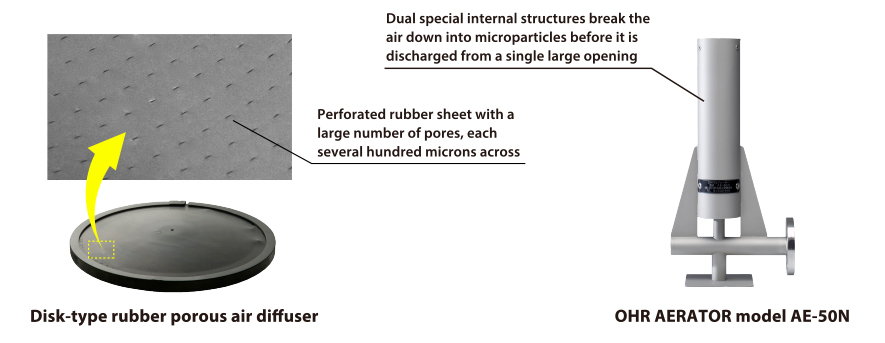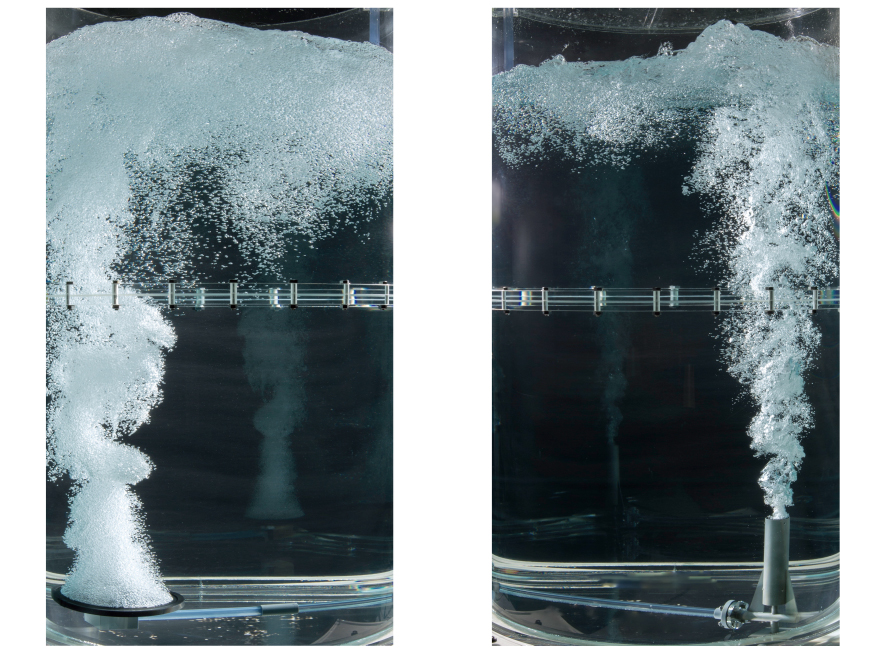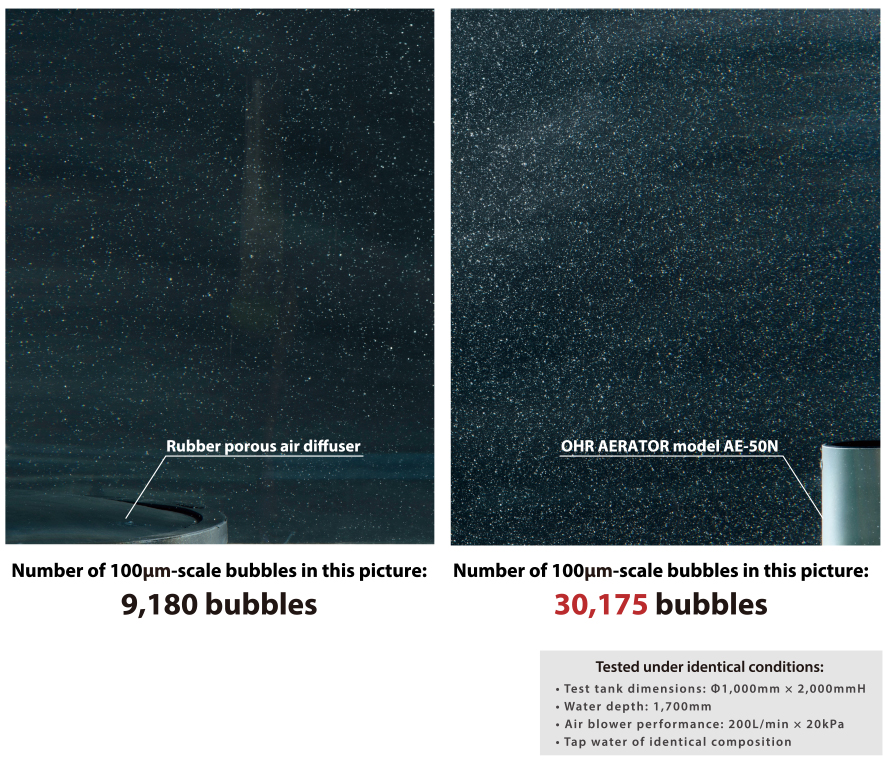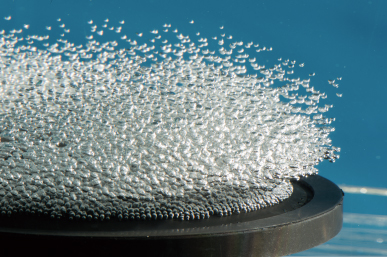Is the OTR of porous air diffusers really that high?
Porous air diffusers vs. OHR AERATOR
Porous air diffusers, particularly rubber ones, are commonly used in wastewater treatment all around the world. Why do so many companies use them despite clogging and the need for repeated cleaning and replacement? The reason is the expectation that porous air diffusers have a high OTR (Oxygen Transfer Rate) because they generate a lot of fine bubbles.
But is this expectation realistic? Is the OTR really that high? Let us verify this in two different ways.
Verification method 1: Porous vs. OHR fine bubble generation experiment
Verification method 2: Real-world comparison of porous diffusers and OHR
What is the ‘alpha value’?
Verification method 1: Porous vs. OHR fine bubble generation experiment
Which air diffuser generates the largest number of 100μm-scale fine bubbles?
Comparative test using two transparent acrylic tanks
Two transparent acrylic tanks were filled with water. In one, a disk-type rubber porous air diffuser was installed; in the other, an OHR AERATOR model AE-50N. The same amount of air was sent to each tank at the same time.
1. How the two air diffusers work

2. Immediately after beginning aeration

3. Condition of the tanks after 60 seconds of aeration
(Photos taken immediately after switching off the air blowers)

Why does the OHR AERATOR generate so many more
fine bubbles than porous air diffusers?
The OHR AERATOR is the only air diffuser in the world with a powerful mixing function, which enables it to generate large numbers of micron-scale fine bubbles.
Porous air diffusers, on the other hand, do not have a mixing function; they simply discharge millimeter-scale bubbles.
Rubber porous air diffusers
These diffusers are unable to generate large numbers of micron-scale fine bubbles. In fact, they discharge uniformly large bubbles (several millimeters to several centimeters across) and can neither break down air nor mix air and water.
A minuscule number of micron-scale bubbles are generated as incidental “fragments” at the moment the millimeter-scale bubbles are produced.

OHR AERATOR
Because the OHR AERATOR breaks down both air and water into microparticles using two kinds of special internal structure, it generates an abundance of micron-scale fine bubbles. For more details, please see the mechanism page.
Mechanism / comparison
Verification method 2: Real-world comparison of porous diffusers and OHR
Porous diffusers vs. OHR at two wastewater treatment plants
In actual wastewater, the OHR AERATOR is much more efficient
The OTR (Oxygen Transfer Rate), which is one indicator of an air diffuser’s performance, is measured in clean water rather than actual wastewater. Rubber porous air diffuser manufacturers advertise a very high OTR of 20–30% at a water depth of 5.0m. At this depth, the OHR AERATOR has an OTR of 10% and so would appear to be very inefficient, judging by the advertised OTR.
However, the OHR AERATOR has a much higher OTR than porous air diffusers when used in actual wastewater. To see why, observe the following two real-world cases.
Case A: In a paper mill
OHR AERATOR used 30% less air than a porous air diffuser, which should have twice the OTR
*Wastewater volume : 12,000m3/day • BOD: 400 mg/L in, 10 mg/L out • BOD load: 4,680 kg/day
A paper mill compared the OHR AERATOR with a rubber porous air diffuser from Company E.
The OTRs advertised by the air diffuser companies at a water depth of 5.5m are as follows:

If the rubber porous air diffuser really does have more than twice the OTR, it should require less than half the air volume. In actuality, by comparing the required air volume that was calculated by the respective companies, the opposite is clear: the OHR AERATOR requires 30% less air than the porous air diffuser.

What’s behind this apparent contradiction? The answer becomes clear when looking at the formula used in Company E’s calculations:

While Company E publicly advertises a high OTR, it ends up being halved when calculating the required air volume. In other words, the calculations are performed with just half the OTR.
Case B: in a beansprout factory
Due to the low efficiency of rubber porous air diffusers, the DO did not rise, resulting in a worsening of treatment conditions
• BOD: 3,000 mg/L in • MLSS: 12,000–13,000 mg/L • Water depth of aeration tank: 4.0m
A beansprout factory installed rubber porous air diffusers from Company M into their aeration tanks.
However, wastewater treatment conditions worsened due to DO (Dissolved Oxygen) in the aeration tanks not rising sufficiently. The customer then swiftly replaced the porous diffusers with OHR AERATORs.
The advertised OTR of each air diffuser at a water depth of 4.0m is as follows:

Since the porous diffuser’s OTR is more than twice that of the OHR AERATOR, the DO ought not to increase when replacing them with OHR AERATORs. In actuality, the DO value more than doubled after replacing the porous air diffusers with OHR AERATORs.

What is the alpha value?
When using a porous air diffuser in wastewater,
the high OTR taken from clean water falls dramatically
As the properties of wastewater differ from site to site (factories, houses, etc.), it is not possible to obtain performance data that applies equally to all wastewater. When the intended use of an air diffuser is for wastewater treatment, the OTR measured in clean water is meaningless because actual wastewater contains many impurities that make dissolving oxygen more difficult. This means that the OTR will fall dramatically when using porous air diffusers.

To obtain the actual OTR in wastewater, multiply the alpha value by the OTR in clean water
Air diffuser manufacturers advertise high OTR, knowing full well that it plummets in wastewater
The alpha value represents how much the OTR in clean water decreases in actual wastewater. Air diffuser manufacturers do not publish it. This value is an important indicator of the true performance of air diffusers because an air diffuser with a high claimed OTR but low alpha value is actually very inefficient in practice — for example, an alpha value of 0.5 means that the OTR falls to 1/2 of the clean water value, and an alpha value of 0.25 means that it falls to 1/4. The alpha value is therefore crucial information when choosing an air diffuser.
However, neither air diffuser manufacturers nor wastewater treatment companies release information on the alpha values of their air diffusers.
What is the alpha value in the two cases above?
In case A, Company E multiplied their OTR by 1/2. This means that the alpha value is 0.5. In case B, the alpha value of Company M’s rubber porous air diffuser is less than 0.25. (Company M’s air diffuser should have more than twice the OTR of the OHR AERATOR, but in wastewaster it is less than 1/2. This means that in wastewater, its actual OTR is 1/4 of its advertised OTR, and, taking the alpha value of the OHR AERATOR to be 1.0, the alpha value of Company M’s diffuser is less than 0.25.)
The OTR of porous air diffusers drops dramatically in actual wastewater
This has been assessed worldwide
1) Singapore’s National Water Agency estimate: 0.23–0.68 (for Singapore sewage)
2) Example from an EPA report*: average of 0.4 *EPA = United States Environmental Protection Agency
From a sewage water treatment plant in New Jersey. This alpha value is from a porous air diffuser on weekdays, at times of high load.
3) OHR’s estimate: 0.2–0.5 (i.e. OTR decreases to about 20–50% in industrial wastewater)
Because industrial wastewater has a high BOD value (several hundred to tens of thousands mg/L), the alpha value will fall considerably, to around 0.2–0.25. On the other hand, the BOD of sewage is very low (around 200–350 mg/L), so the decrease is relatively small compared to industrial wastewater. The OTR, however, falls dramatically even in sewage water, as is becoming increasingly evident worldwide.
(In Japan, the OHR AERATOR is used only for industrial wastewater, not sewage water; the alpha value of 0.2–0.5 therefore only applies to industrial wastewater.)
OHR AERATOR’s alpha value is approximately 1.0
No decrease in efficiency, even in actual wastewater
The alpha value of the OHR AERATOR is approximately 1.0. This means that the OTR does not change between clean water and actual wastewater. The evidence for this is as follows.
Evaluation report from an engineering company
We received from a report from wastewater treatment engineering company S that stated “there appears to be no reduction in OTR, even in actual wastewater.” The report mentions the following:
“In order to measure the OTR in actual wastewater, synthetic wastewater was produced by adding 5.0 ppm of surfactant to tap water, and the percentage decrease in OTR was measured. The OTR of the conventional air diffuser in the wastewater decreased by about 30% compared with the tap water. The OHR AERATOR, meanwhile, displayed the same OTR value in both. From this it is inferred that the OTR of the OHR AERATOR will remain virtually unchanged when used in actual wastewater.”
We have used an alpha value of 1.0 in our calculations for over thirty years
We have performed calculations using an alpha value of 1.0 for more than 30 years and have never had a case that resulted in deficient treatment due to lack of oxygen. We are also transparent in providing customers with the formulae used to calculate the required volume of blown air based on an alpha value of 1.0.
Why does our OTR not change between clean water and wastewater?
The OHR AERATOR’s alpha value of 1.0 is thanks to its unique ability to powerfully mix air and wastewater, as well as its special internal structures. In fact, when operated under the same conditions, the OHR AERATOR generates over 3.3× the amount of fine (100μm-scale) bubbles than rubber porous air diffusers. It is the action of breaking down air and wastewater into fine particles and colliding them that allows an alpha value of 1.0 to be realized.
Verification method 1: Porous vs. OHR fine bubble generation experiment Mechanism / comparison












